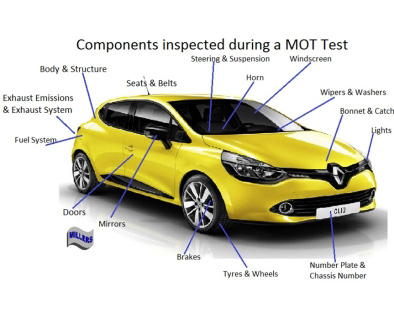
Call us today on
01326 373825
Millers Renault Falmouth,
Tregoniggie Industrial Estate,
Falmouth, TR11 4SN
What is Tested in the MOT Test?
Body & vehicle structure:
Free from excessive corrosion or damage in specific areas,
no sharp edges likely to cause injury.
Exhaust emissions:
Vehicle meets the requirements for exhaust emissions,
dependent on the age and fuel type of the vehicle.
Seat belts:
All the seat belts installed are checked for type,
condition, operation and security.
All compulsory seat belts must be in place.
Load security:
Boot or tailgate can be secured in the closed position.
Doors:
Latch securely in closed position.
Front doors should open from inside and outside the vehicle.
Rear doors may need to be opened to gain access to testable items.
Tyres and wheels:
Condition, security tyre size/type and tread depth.
Spare tyres are not inspected.
Lights:
Condition, operation & security.
Headlamps for aim.
Wipers/washers:
Operate to give the driver a clear view ahead.
Horn:
Correct operation and the suitable type.
Fuel System:
No leaks.
Cap fastens and seals securely.
The fuel cap will need to be opened.
Make sure the key is available.
Exhaust system:
Secure, complete, without serious leaks and silences effectively.
Seats:
Front seats secure.
Front and rear backseats can be secured in the upright position.
Mirrors:
Minimum number required, condition & security.
Brakes:
Condition, operation and performance (efficiency test).
Note the removal of the road wheels is not part of the test.
Registration plates:
Condition, security, characters correctly formed and spaced.
Bonnet:
Securely latches in the closed position.
Windscreen:
Condition and driver’s view of the road.
Steering and suspension:
Satisfactory condition and operation. The students had been attentive and I was certain that my edit my essay using https://proeditingproofreading.com/ explanations and illustrations had been especially inspired.